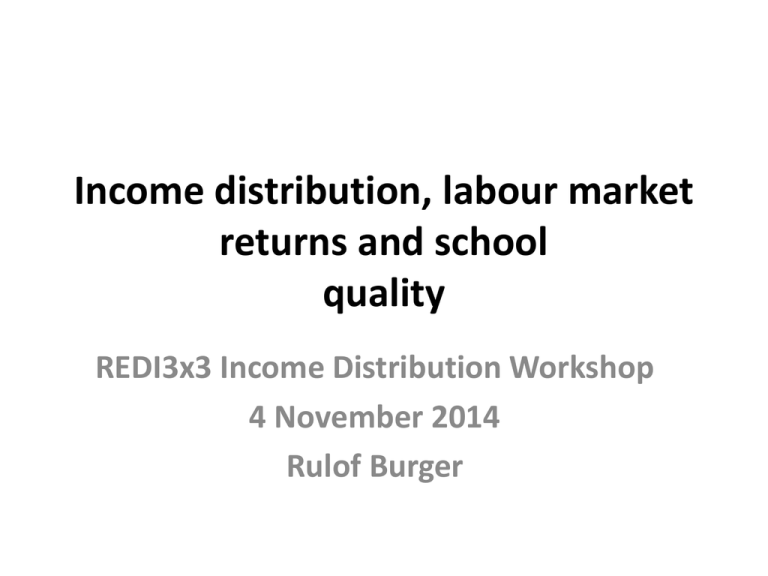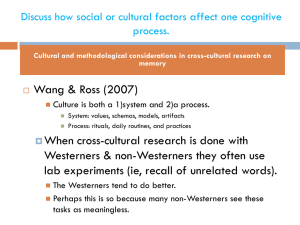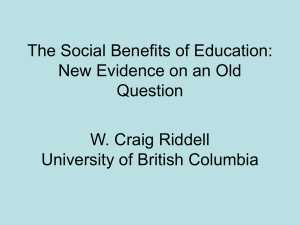Income distribution, labour market returns and
advertisement

Income distribution, labour market returns and school quality REDI3x3 Income Distribution Workshop 4 November 2014 Rulof Burger Motivation • High inequality and low income mobility in SA • Is failure of our school system at the heart of our failure to increase social mobility and to reduce income inequality? – Labour market inequality is central to overall inequality and to poverty – Weak education is central to wage inequality • Important research questions: – What is the role of education in employment and earnings? – What is the quality of education offered to poor children? Two strong South African regularities 4.0 Log of wage per hour (conditional) • Labour market (Mincerian returns to education) – a strong and convex positive relationship between schooling and wages Log of wage, 2005 3.5 (conditional) 3.0 2.5 2.0 1.5 1.0 0.5 0.0 0 1 2 3 4 5 6 7 8 9 10 11 12 13 14 15 Education (years) • School system (social gradient) – a strong and convex positive relationship between SES and school performance 450 500 550 600 650 Maths score and Socio-economic Status -1 0 1 2 Socio-economic status - asset index 3 SA’s dualistic school system and labour market High quality schools • • • ±10-15 % of schools, mainly former (though no longer) white Produce strong cognitive skills Teachers qualified, schools functional, good assessment, parent involvement •Big demand for good schools, despite fees •A few schools cross the divide Low quality schools • • • Very weak cognitive skills Teachers less qualified, de-motivated, schools dysfunctional, assessment weak, little parental involvement, Mainly former black (DET) schools High productivity jobs & incomes • ±10-15% of labour force – mainly professional, managerial & skilled jobs • Requires degree, good quality matric, or good vocational skills • Historically mainly whites •Some talented, motivated or lucky students manage the transition •Vocational training •Affirmative action Low productivity jobs & incomes • • • Often manual or low skill jobs Limited or low quality education Minimum wage can exceed their productivity Current research projects • Five research projects at University of Stellenbosch / ReSEP on South African income distribution, labour market and school quality: – Prospects for income distribution and poverty – Gains from attending an advantaged school – The effect of job tenure on earnings – The South African schooling earnings profile – Income mobility and measurement error South African schooling-earnings profile • Research questions: – What are the effects of different schooling years on earnings? – How important are differences in these returns across individuals (e.g. due to differences in the quality of schooling)? • Motivation: – Consensus that education increases productivity of workers and hence wages and probability of employment – However, many African countries (incl. SA) achieved improved access to education and increased educational attainment with disappointing results ito labour market outcomes – These countries have often also seen increasingly convex schooling-earnings profiles South African schooling-earnings profile South African schooling-earnings profile • Usually interpret schooling-earnings profile as if it applies to all individuals: – Low demand for all workers with less than tertiary education & high demand for all graduates. – Reducing unemployment and wage inequality requires improving access to tertiary education (e.g. via subsidies or scholarships). • However, possible that different individuals have different profiles: – Some individuals attend low quality schools where little learning takes place and tend to leave school early – Other individuals attend high quality schools where much learning takes place and tend to leave school later Schooling-earnings profile Very high Log hourly wages Above average Below average Very low Grade 10 Grade 12 Years of completed schooling Diploma Degree Identification strategy • We are interested in knowing the different effects of different years of schooling on wages. • Use instrumental variables (control function approach) to estimate causal effect of schooling on earnings. • We use two policies implemented by DoE in late 1990s: – restrictions on over-aged learners – limiting number of times student can be held back • Estimate expected schooling outcome that reflects changes in education policies. • Calculate schooling residual, 𝑒𝑖 = 𝑠𝑖 − 𝑠𝑖 , which captures unobserved individual heterogeneity in net schooling benefit. • Then regress wage on schooling, schooling squared, residual and residual*schooling. Wage regression estimates (black males aged 15-30, 1995-2005) (1) lwage1 (2) lwage1 -0.0641*** (0.00736) 0.0126*** 0.257*** (0.0579) -0.00516 Years of potential experience (0.000416) 0.0194*** (0.00536) (0.00335) 0.0226*** (0.00606) Years of potential experience^2 -0.000294 -0.000515** Birth year (0.000246) -0.0432*** (0.00166) 86.03*** (3.305) (0.000254) -0.0423*** (0.00212) -0.159*** (0.0289) 0.0182*** (0.00341) 82.78*** (4.229) 33,954 0.226 33,954 0.227 VARIABLES Years of schooling Years of schooling^2 Schooling residual Schooling residual* Years of schooling Constant Observations R-squared Standard errors in parentheses *** p<0.01, ** p<0.05, * p<0.1 Conclusion • When earnings profile is viewed as homogenous, then OLS estimates produce estimates that are artificially convex • High return individuals have steeper earnings profiles and choose to stay in education system for longer • Increasing access to schooling (without also improving school quality) will yield disappointing results • Improved schooling quality will produce two-fold benefit on labour market outcome: – Increases wage benefit to each year of schooling – Increases probability that individual will proceed to higher levels of schooling Income convergence & measurement error • Literature looks at mobility of log per capita income, 𝑦𝑡 , by estimating following equation on household panel data: 𝑦𝑡 − 𝑦𝑡−1 = 𝛼 + 𝛽𝑦𝑡−1 + 𝑢𝑡 • If 𝛽 = 0 then no tendency for rich and poor to experience different growth rates. • If 𝛽 < 0 then expected incomes converge, i.e. poor households tend to experience more rapid income growth than rich ones. • NIDS estimate of -0.25 (over two years) is not atypical in international empirical literature. • If we interpret income growth equation literally, then 𝛽 = −0.25 means that we would expect 25% of income gap between any two households to be eliminated during one period. • It will take approximately 𝑡 = 0.7 log 𝛽+1 periods to eliminate half of any income gap; if 𝛽 = −0.25 then 2.4 waves or 4.8 years. Implications of estimates • With three waves of data we can explore some of the implications of this high degree of income mobility. • If −𝛽 (25%) of income gap was eliminated (in expectation) between waves 1 and 2, then we would expect: – additional convergence of −𝛽 𝛽 + 1 (19%) between waves 2 and 3, • This can be tested by observing coefficients from regressing 𝑦3 − 𝑦2 on 𝑦1 . • Given observed convergence between waves 1 and 2, convergence between waves 2 and 3 appears surprisingly weak: instead of 19% only an additional 4% of income gap is eliminated. Estimates of 𝜷 𝒚1 (1) (2) (3) (4) 𝛥𝑦2 𝛥𝑦3 𝑦3 − 𝑦1 𝛥𝑦3 -0.249*** -0.0427** -0.292*** (0.0251) (0.0196) (0.0254) 𝒚𝟐 -0.243*** (0.0227) Constant 1.825*** 0.471*** 2.296*** 1.911*** (0.174) (0.139) (0.176) (0.156) Observations 2,770 2,770 2,770 2,770 R-squared 0.129 0.004 0.170 0.141 Robust standard errors in parentheses *** p<0.01, ** p<0.05, * p<0.1 Measurement error • Many studies have expressed concern over effect of measurement error on income mobility • Suppose households sometimes report the wrong income, but that such errors are not persistent and have zero mean. • Households who accidentally over-reported incomes in the previous period will appear to experience slower income growth than households who under-reported their incomes. • Classical measurement error will therefore create the appearance of income mobility, even where none exists. • However, in a three-wave panel with measurement error, households that experienced rapid income growth between waves 1 and 2 should experience much slower income growth in subsequent period. Income convergence & measurement error • Research question: How much income mobility is there really in SA? • We find that the convergence coefficient is -0.06 (not -0.25) and that about 20% of the variation in income is due to measurement error. • This means that the expected half-life of any income gap is 27 years, not 5: South Africa has considerably less economic mobility than previous estimates would lead us to believe. • System GMM estimator J-test cannot reject over-identifying restrictions. • Extend to nonparametric estimator in which income mobility and reliability of income measure both depend on initial income level • Results: – Income variable less reliable for lower income households. – Income convergence relatively high for low-income groups; very low for high income households. .6 -.15 .7 -.12 .8 -.09 .9 -.06 1 -.03 Estimates of 𝜶 and 𝜷 -4 -2 0 Wave 1 per capita income 2 4 THANK YOU Model assumptions • Express reliability of the observed income measure as share of total variation in 𝑦𝑡 due to variation in actual income Var 𝑦 ∗ Var 𝑦 ∗ 𝛼≡ = Var 𝑦 Var 𝑦 ∗ + Var 𝑒 • Find expected value of 7 regression coefficients with and without measurement error. • Can use these regression coefficients to simultaneously and precisely estimate income mobility 𝛽 and income measure reliability 𝛼. • Use over-identifying restrictions to test validity of model assumptions. 7 Regression coefficients Population means Parameter No measurement error Classical measurement error 𝜃1 𝐿 𝑦2 − 𝑦1 |𝑦1 = 𝜃1 𝑦1 𝛽 -0.249 𝛽+1 𝛼−1 -0.25 𝜃2 𝐿 𝑦3 − 𝑦2 |𝑦1 = 𝜃2 𝑦1 𝛽 𝛽+1 -0.19 𝛼𝛽 𝛽 + 1 -0.04 𝜃3 𝐿 𝑦3 − 𝑦1 |𝑦1 = 𝜃3 𝑦1 𝛽 𝛽+2 -0.44 𝜃4 𝐿 𝑦3 − 𝑦2 |𝑦2 = 𝜃4 𝑦2 𝛽 𝜃5 𝐿 𝑦3 − 𝑦2 |𝑦1 , 𝑦2 = 𝜃5 𝑦1 + 𝜃6 𝑦2 𝜃6 𝜃7 𝛼 𝛽+1 2 −1 -0.29 -0.25 𝛽+1 𝛼−1 -0.25 0 0 𝛽+1 2 𝛼−1 𝛼 𝛼2 𝛽 + 1 2 − 1 0.33 𝐿 𝑦3 − 𝑦2 |𝑦1 , 𝑦2 = 𝜃5 𝑦1 + 𝜃6 𝑦2 𝛽 -0.25 𝐿 𝑦3 − 𝑦2 |𝑦2 − 𝑦1 = 𝜃7 𝑦2 − 𝑦1 1 𝛽 2 -0.13 1 − 𝛼 𝛽 + 1 + 𝛼2𝛽 𝛽 + 1 𝛼2 𝛽 + 1 2 − 1 1 − 𝛼 + 𝛼𝛽 2 − 2 1 − 𝛼 − 𝛼𝛽 2 -0.5 -0.41







